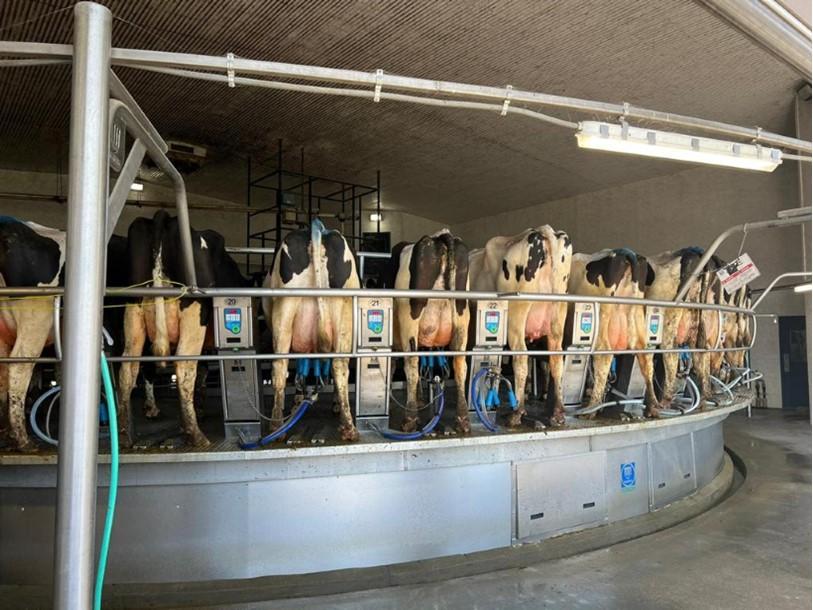Overview of Mastitis

Mastitis is an infection of the mammary gland. It occurs when certain pathogens (including coliforms, S. Aureus, mycoplasma, and other bacteria) enter the udder through the teat streak canal. Common pathways that these bacteria get into the teat is during and right after milking (Erskine. 2020). During milking, bacteria can enter the teat from the milking equipment or the milkers’ hands. After milking, the teat canal remains open for 30 minutes, during which bacteria can enter from many places, specifically if the cow lays down somewhere unhygienic (Krekelberg. 2020). Mastitis causes major economic loss, reduced cow welfare, and poor-quality milk and if severe, it can lead to the inability to produce milk by affected quarters (Erskine. 2020).
Types of Mastitis:
- Clinical Mastitis:
- Visible infection with abnormal milk.
- Often presents with udder swelling and increased somatic cell count.
- Subclinical Mastitis:
- No visible symptoms.
- Milk appears normal, but somatic cell count is high.
- Overall poor management of the dairy operation.
- Signs and Symptoms:
- Udder swelling, redness, and tenderness.
- Painful for the cow.
- Abnormal color and/or texture of milk.

Classification of Mastitis:
- Environmental Mastitis:
- Infection from outside environment (e.g., E. coli, Strep. Uberis).
- Can result from dirty alleys, bedding, standing water, etc.
- Contagious Mastitis:
- Bacteria naturally occurring on cows.
- Transferred from cow to cow through milking equipment.
Risk Factors for Mastitis:
- Improper cleaning at all milking process steps (walls, machines, hands, floors, etc.).
- Increased interaction among different dairy herds.
- Poor udder and teat conformation.
- Stage of lactation.
- Overall poor management of the dairy operation.
Testing for Mastitis:
- Herd Level:
- Bulk Tank Somatic Cell Count:
- Measures somatic cell count in milk collected from all cows.
- Effectiveness can vary; may not detect issues if only a few cows have mastitis in a large herd.
- Cell Cultures:
- Can be done from a bulk tank or an individual cow's milk.
- Specifies bacteria causing the infection.
- PCR (Polymerase Chain Reaction):
- Examines DNA to determine pathogens.
- Costly but highly sensitive.
- Particularly helpful in detecting mycoplasma faster than culture (Marshall and Edmondson. 1993).
- Bulk Tank Somatic Cell Count:
- Individual Level:
- California Mastitis Test:
- Milk from each teat is individually mixed with a reagent in a paddle.
- Appearance of the milk determines the level of infection.
- Gel formation indicates a higher presence of somatic cells.
- California Mastitis Test:
Treating Mastitis:
- Antibiotics:
- Examples include penicillin.
- Administered through intramammary infusions, IM (intramuscular), or IV (intravenous) injections (Cheng and Han. 2020).
- Treatment decisions made on a case-by-case basis, considering the cost versus the value of the dairy cow.
Effectiveness and Limitations:
- Treatment outcomes are not guaranteed.
- Success varies, and not all cases respond positively.
Preventing Mastitis:
- Emphasizes proactive strategies to avoid mastitis.
- Acknowledged as the best approach for managing mastitis.
Proper Facility Management:
- Maintain cleanliness in all milking barn areas, equipment, alleyways, walls, and floors.
- Ensure clean and dry bedding; avoid overcrowding.
- Properly assess new cows for mastitis history or clinical signs.
- Quarantine cows exhibiting mastitis signs; minimize cow-to-cow interactions between herds.
Proper Milking Practices:
- Hygiene Practices:
- Workers use gloves and clean equipment and towels for each cow.
- Administer pre and post-milking germicide dips to teats.
- Milking Process:
- Avoid overmilking.
- Provide feed post-milking to keep cows standing, reducing mastitis risk.
- Vaccination:
- Specific vaccines address mastitis-causing bacteria like Staph. Aureus.
References:
- Cheng W. & Han S. 2020. Bovine mastitis: risk factors, therapeutic strategies and alternative treatments- A review Asian-Australas Journal of Animal Science https://www.ncbi.nlm.nih.gov/pmc/articles/PMC7649072/.
- Erskine R. 2020. Mastitis in Cattle Merck Manual Veterinary Manual https://www.merckvetmanual.com/reproductive-system/mastitis-in-large-animals/mastitis-in-cattle.
- Krekelberg E. 2020. Timing the milking procedure University of Minnesota Extension https://extension.umn.edu/dairy-milking-cows/timing-milking.
- Marshall R. & Edmondson J. 1993. Using the California Mastitis Test Missouri Extension https://extension.missouri.edu/publications/g3653.
This article appears on December 2023, in Volume 4, Issue 3 of the Maryland Milk Moos newsletter.
